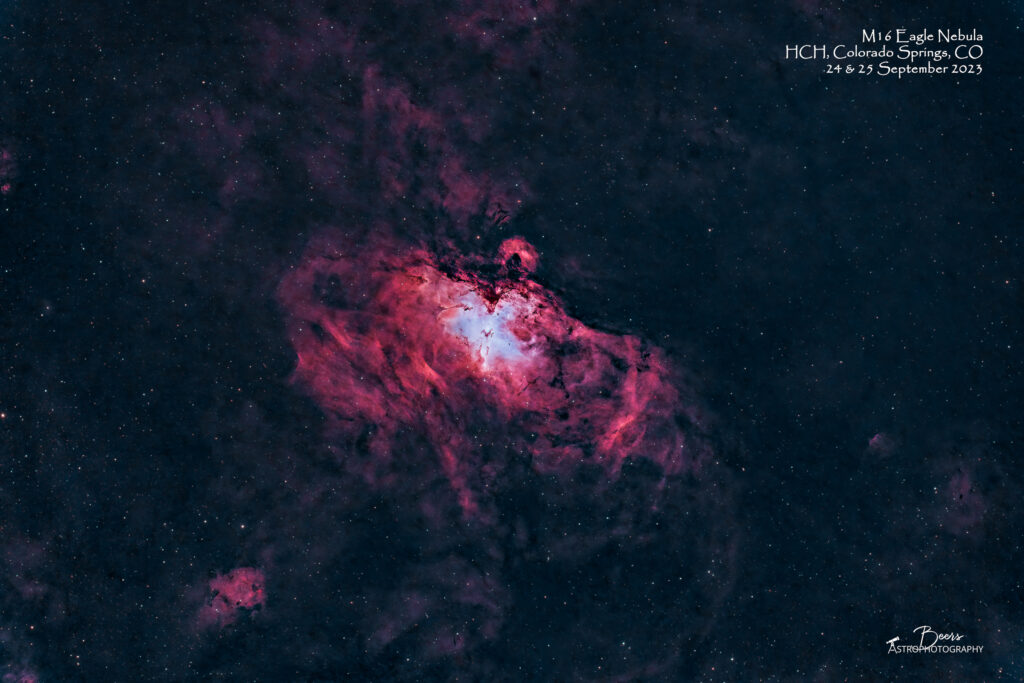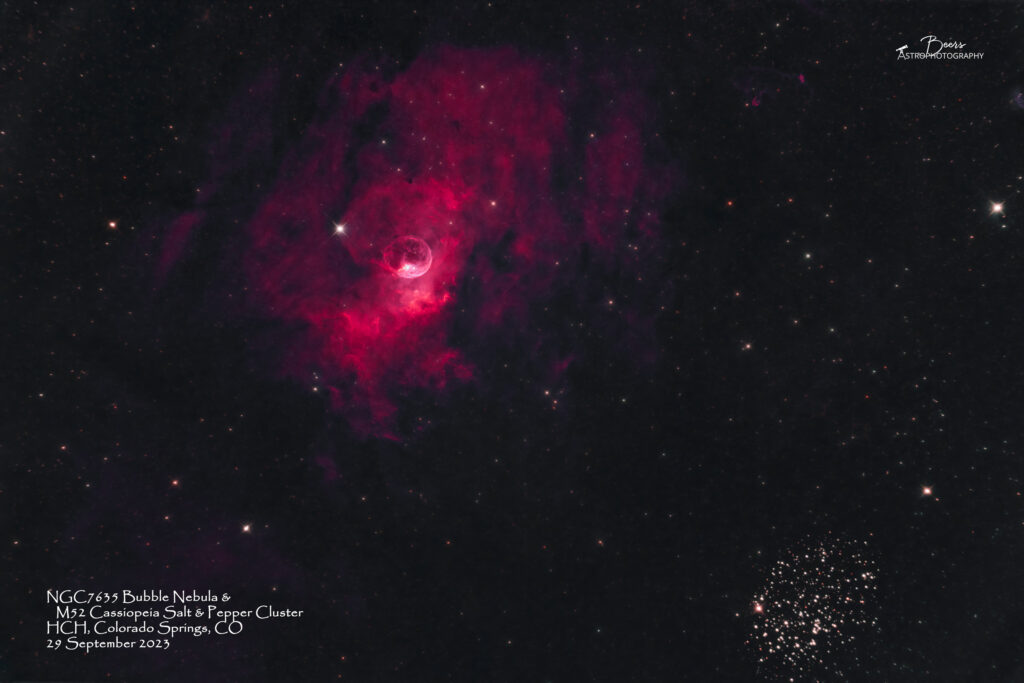Our September dark skies trip was cancelled due to storms, rain, and clouds at every dark sky location within a 400 mile radius. But in true form, Mother Nature has filled the rest of the month with clear skies - not all that dark, but we'll take what we can get!
There are still a few more images in the queue to be processed...so stand by for more updates! But I also need to do some capture planning, equipment testing, and packing for our October trip - which WILL happen for the annular solar eclipse on 14 October 2023!! So, you'll have to be a little patient with me (says she with NO patience!)...I will get caught up and post the rest of the images I've captured this month.

M16 Eagle (or Star Queen) Nebula
Capture Notes:
Beginning on Sunday, 24 September 2023 we had a week of clear skies at home (with the moon building to the full Harvest Supermoon on Friday, 29Sep2023). I had finally convinced Orion that I REALLY did need the extension tube for Big Bertha and they relented to sell it to me. I ordered on it Friday, 22 September and it was to be shipped on Monday. So, I decided to use the Southern Cross while I waited for the missing piece to make ASI2400-BB whole. Although I was past prime viewing time (in late spring and early summer), with a bit of passive aggressive streak (still hanging on to the annoyance that an AP workshop organizer was going to have us traveling all the way to Chile to photograph this image, that you can see if visible from the front patio!), I decided to start the evening(s) imaging the M16 Eagle Nebula until it set at approximately 2300MDT. Both night’s (24 Sep & 25 Sep) capture went well, with the target being well past the meridian when I started and setting in the southwest, so I could continue to image past the point of the house’s 20° horizon.
Processing Highlights: As usual, I captured the data with SGP, removed stars with Starnet++, and processed with LR/PS.
I stacked several versions of the image in APP (HaOIII Color, HaOIII Extract Ha, and HaOIII Extract OIII) to potentially use Nico Carver’s method of colorizing the Ha and OIII mono images. It turned out that this image’s workflow was a hybrid between my “standard” process using AW presets to bring out colors/hues and Nico Carver’s colorizing the Ha and OIII images. After getting the image to the point that I liked the overall color/hue, I was still dissatisfied with the “chest” of the Eagle being so white vs. showing some of the blues that I knew I’d captured in the OIII wavelength. So, I used the HaOIII extract OIII STARLESS layer to create a colorized (blue) layer that I “painted it in” to the image.
The gallery entry, for the “rest of the story” is here: https://beersastrophotography.com/gallery/m16-eagle-nebula/

NGC7635 Bubble Nebula (with M52 Cassiopeia Salt and Pepper Nebula)
Capture Notes: Clear night (albeit full moon) gave me the chance to test out the new extension tube I finally was successful in convincing Orion that I needed, they admitted they had it in stock, and “allowed” me to purchase it. Also, I wanted to experiment with the Teleskop Field Flattener, which worked very well at correcting coma (the comma shaped stars in the corner of the image) when used with my Canon EOS Ra with my first try with the ASI2400, it created more coma than it corrected. I had looked up the design distance between the sensor and the flattener, the manufacturer said it provided “a generous” 109mm. I measured from the glass plate (I’m not sure how far back the sensor is from there) to the sensor side of the FF, it seemed in the range of 109mm, so I convinced myself that I must have used an extra sleeve of the connection tube in previous attempts. Turns out that I had the same (worse coma with the FF than without) even with that recommended separation, so I stopped the sequence after one image, took off the FF, refocused, and restarted the sequence without the use of the FF. There is still some coma (which is frustrating because I framed the image to include the M52 star cluster in the SE corner and the stars in the cluster look more like a comma convention! Other than that, the data collection went remarkably well throughout the night. The sequence did abort somewhere after 2333MDT (transit was 2347MDT). I came out to do the meridian flip at about midnight and was able to successfully restart the sequence (on the correct side of the meridian) without issue. So the mystery of meridian flip +/- 15minutes continues…
Processing: This image is 8:20 hours of data captured with SGP throughout the night on Friday, 29 September. Stacked in APP (HaOIII Color, HaOIII Extract Ha, and HaOIII Extract OIII). Star removal with Starnet++. Processed in LR/PS using “standard” hue/saturation processing with the help of Alyn Wallace’s LR presets.
The “rest of the story” is at: https://beersastrophotography.com/gallery/ngc7635-bubble-nebula/
